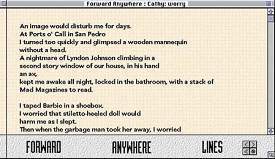
It might be useful to think of current literary hypertextual work as belonging to a third generation. The first generation of hypertext was created by programmer artists with hand coding or with HyperCard and was built on the ideas of Vannevar Bush and Ted Nelson (who, along with his enormous contribution to personal computing, coined the term 'hypertext' in the 60's). This generation of pioneers undertook explorations of the new computing technology, drawing the first maps of electronic texts and exploring the concept of automated links, but in textual forms which contained few, if any, graphics. Few of these early examples function on contemporary computing systems, but see, for example, Jim Rosenberg's Intergrams (1994), Rod Willmot's hyperpoem Everglade (1990) or Tim McLaughlin's 1990's translation of bpNichol's 1980's concrete electronic poetry for the Apple II into online Java-based kinetic text. (A version of bpNichol's electro-poetics has been published on disk as First Screenings, Red Deer College Press, 1997). The first electronic hyperfiction was written by Judy Malloy in 1986. Uncle Roger, called a "narrabase" by Malloy, was envisioned by her as a "pool of information into which the reader plunges repeatedly" (Malloy, 1998). While graphics and colour have been added for the 1995 web translation, Malloy originally posted this on the equivalent of an online conference, the Art Com Electronic Network on the WELL. More than a text, it was an online interactive experience: the audience reacted, commented and made additions to the narrative (Malloy, 1998).
Hypertext's second generation was born of a single, visionary work: the 'Gutenberg Bible' of hypertexts was Michael Joyce's afternoon, a story (1987). This second generation introduced much more sophisticated automated links, colour, random elements and started to integrate both typographic design and images as a part of the text. See Martha Conway's Girl Birth Water Death, Carolyn Guyer's Quibbling, Shelley Jackson's Patchwork Girl or Judy Malloy and Cathy Marshall's Forward Anywhere, as illustrated below:
 |
| From Forward Anywhere by Judy Malloy and Cathy Marshall. Published by Eastgate Systems. Reproduced by permission. |
We are just beginning to see the first hatchings of the third generation of hypertext with the introduction of VRML, movies, sound, JavaScript, cgi functions, and other magical elements into literary texts. Even Storyspace exports to html now and is much more image friendly. This third generation embodies the hum of a truer interactivity and consists of hypertexts that do not simply use images, but integrate the visual element as a part of the narrative and physical structure of the text. This includes the likes of Christy Sheffield Sanford's Red Mona, Adriene Jenik's Mauve Desert: A CD-ROM Translation, M.D. Coverley's The Lacemaker, Elys and Olia Lialina's My Boyfriend Came Back From the War. In this third hypertextual generation, the distinction between 'artist' and 'writer' (and, one could argue, 'programmer,' if we consider programming to be a creative form) begins to break down--a symptom of the avant-garde to be sure. Jean Gagnon states that what we are witnessing is a "paradigm shift" (291), a change in the way we perceive and interact with culture and media and, therefore, with the world.
Back in the 60's, McLuhan argued that this transition exhibited all the growing pains of a metamorphosis: our entrance into a third age of historical comprehension. The first age, he said, was the "un-perspective world," that of the pre-Socratic philosophers with their belief in the holistic unity of all things. The second age was the "perspective world" of the Renaissance, where linearity was born through the written and, particularly, the printed word. The third age, McLuhan argued, is what we are living now: an "a-perspective world" birthed from the spark of electricity and come of age in the computer. In the third age, "post-literacy" dominates and the analogue is replaced by the digital, shifting our perception of our senses and the way in which we interact with the world. (qtd, Gagnon 293-294). Living on the faultline of a volatile structural shift, it is impossible to predict what narrative and feminist hypertext will look like and do a decade or even a year from now.

Carolyn Guertin